Methodological Study on the Full-Range Pore Structure and Fractal Characteristics of the Tight Reservoirs
Abstract
:1. Introduction
2. Materials and Methods
2.1. Geological Background and Samples
2.2. Experimental Method
3. Results
3.1. Lithology and Diagenesis
3.2. Results and Analysis of N2-GA Experiments
3.3. Results and Analysis of MIP Experiments
3.4. Experimental Results and Analysis of MAPs
4. Discussion
4.1. Combining Different Experiments to Characterize the Full-Range PSD
4.1.1. The Principle of Combining the Different Experiments
4.1.2. Using MAPs to Verify the Rationality of the Data Splicing
4.2. Full-Range Fractal Study of Reservoir’s Heterogeneity
4.2.1. Two-Dimensional Fractal Dimension Calculation Model
4.2.2. Three-Dimensional Fractal Dimension Calculation Model
4.2.3. Discussion of the Fractal Dimension of the MIP
4.2.4. The Values of the Segmented Fractal Pore Size
4.2.5. The Relationship between Fractal Dimensions of Different Dimensions
5. Conclusions
Author Contributions
Funding
Data Availability Statement
Conflicts of Interest
References
- Zou, C.; Zhu, R.; Bai, B.; Yang, Z.; Wu, S.; Su, L.; Dong, D.; Li, X. First discovery of nano-pore throat in oil and gas reservoir in China and its scientific value. Acta Petrol. Sin. 2011, 27, 1857–1864. [Google Scholar]
- You, Y.; Niu, X.; Feng, S.; Wang, F.; Wang, C.; Li, W. Study of pore features in Chang7 tight oil reservoir, Yanchang layer, Ordos Basin. J. China Univ. Petrol. 2014, 38, 18–23. [Google Scholar]
- Zhu, R.; Wu, S.; Su, L.; Cui, J.; Mao, Z.; Zhang, X. Problems and future works of porous texture characterization of tight reservoirs in China. Acta Petrol. Sin. 2016, 37, 1323–1336. [Google Scholar]
- Tian, H.; Zhang, S.; Liu, S.; Zhang, H. Determination of organic-rich shale pore features by mercury injection and gas adsorption methods. Acta Petrol. Sin. 2012, 33, 419–427. [Google Scholar]
- Cao, T.; Song, Z.; Liu, G.; Yin, Q.; Luo, H. Characteristics of shale pores, fractal dimension and their controlling factors determined by nitrogen adsorption and mercury injection methods. Petrol. Geol. Recovery Effic. 2016, 23, 1–8. [Google Scholar]
- Xiao, D.; Lu, S.; Lu, Z.; Huang, W.; Gu, M. Combining nuclear magnetic resonance and rate-controlled porosimetry to probe the pore-throat structure of tight sandstones. Petrol. Explor. Dev. 2016, 43, 961–970. [Google Scholar] [CrossRef]
- Jiang, Z.; Tang, X.; Li, Z.; Huang, H.; Yang, P.; Yang, X.; Li, W.; Hao, J. The whole-aperture pore structure characteristics and its effect on gas content of the Longmaxi Formation shale in the southeastern Sichuan basin. Earth Sci. Front. 2016, 23, 126–134. [Google Scholar]
- Zhang, J.; Li, X.; Wei, Q.; Sun, K.; Zhang, G.; Wang, F. Characterization of Full-Sized Pore Structure and Fractal Characteristics of Marine–Continental Transitional Longtan Formation Shale of Sichuan Basin, South China. Energy Fuels 2017, 31, 10490–10504. [Google Scholar] [CrossRef]
- Wang, X.; Jiang, Z.; Jiang, S.; Chang, J.; Zhu, L.; Li, X.; Li, J. Full-Scale Pore Structure and Fractal Dimension of the Longmaxi Shale from the Southern Sichuan Basin: Investigations Using FE-SEM, Gas Adsorption and Mercury Intrusion Porosimetry. Minerals 2019, 9, 543. [Google Scholar] [CrossRef]
- Jia, F.; Shen, P.; Li, K. Study on the Fractal Characteristics of Sandstone Pore Structure and Its Application. Fault-Block Oil Gas Field 1995, 01, 16–21. [Google Scholar]
- Wang, Z.; Jiang, X.; Pan, M.; Shi, Y. Nano-Scale Pore Structure and Its Multi-Fractal Characteristics of Tight Sandstone by N2 Adsorption/Desorption Analyses: A Case Study of Shihezi Formation from the Sulige Gas Filed, Ordos Basin, China. Minerals 2020, 10, 377. [Google Scholar] [CrossRef]
- Yao, Y.; Liu, D.; Tang, D.; Tang, S.; Huang, W. Fractal characterization of adsorption-pores of coals from North China: An investigation on CH4 adsorption capacity of coals. Int. J. Coal Geol. 2008, 73, 27–42. [Google Scholar] [CrossRef]
- Bu, H.; Ju, Y.; Tan, J.; Wang, G.; Li, X. Fractal characteristics of pores in non-marine shales from the Huainan coalfield, eastern China. J. Nat. Gas Sci. Eng. 2015, 24, 166–177. [Google Scholar] [CrossRef]
- Li, Y.; Wang, Z.; Pan, Z.; Niu, X.; Yu, Y.; Meng, S. Pore structure and its fractal dimensions of transitional shale: A cross-section from east margin of the Ordos Basin, China. Fuel 2019, 241, 417–431. [Google Scholar] [CrossRef]
- Qiao, P.; Ju, Y.; Cai, J.; Zhao, J.; Zhu, H.; Yu, K.; Qi, Y.; Meng, S.; Li, W.; Sun, Y.; et al. Micro-Nanopore structure and fractal characteristics of tight sandstone gas reservoirs in the eastern Ordos basin, China. J. Nanosci. Nanotechnol. 2021, 21, 234–245. [Google Scholar] [CrossRef]
- Lai, J.; Wang, G.; Zheng, Y.; Li, W.; Cai, C. Method for calculating the fractal dimension of the pore structure of low permeability reservoirs: A case study of the Xujiahe formation reservoir in central Sichuan basin. J. Northeast Petrol. Univ. 2013, 17, 1–7. [Google Scholar]
- Zhang, Q.; Hou, G.; Pan, W.; Han, J.; Ju, Y.; Li, L.; Ju, W.; Shu, W. Fractal Study on Structure Fracture. J. Basic Sci. Eng. 2011, 19, 853–861. [Google Scholar]
- Feng, X.; Zhu, H. Micro-pore Structure and Fractal Characteristics of the Xiashihezi Formation Tight Reservoir in Sulige Area in Ordos Basin. Geol Sci. Technol. Inform. 2019, 38, 147–156. [Google Scholar]
- Yan, J.; He, X.; Geng, B.; Li, X.; Guo, H. Models Based on Fractal Theory to Assess Pore Structure of Low Permeability Sand Reservoirs. Well Logging Technol. 2017, 41, 345–352. [Google Scholar]
- Peng, J.; Han, H.; Xia, Q.; Li, B. Fractal characterization and genetic mechanism of micro-pore structure in deeply buried tight sandstone reservoir: A case study of Kalpintag Formation in Shuntuoguole area, Tarim Basin. Acta Petrol. Sin. 2018, 39, 775–791. [Google Scholar]
- Fu, J.; Liu, X.; Li, S.; Guo, Q.; Zhou, X.; Yang, W. Discovery and resource potential of shale oil of Chang 7 member, Triassic Yancahng Formation, Ordos Basin. China Petrol. Explor. 2021, 26, 1–11. [Google Scholar]
- Guo, Y.; Li, W.; Guo, B.; Zhang, Q.; Chen, Q.; Wang, R.; Liu, X.; Ma, Y.; Li, Z.; Zhang, M.; et al. Sedimentary systems and palaeogeography evolution of Ordos Basin. J. Palaeogeograpjy 2019, 21, 293–320. [Google Scholar]
- Yang, J. Tectonic Evolution and Oli-Gas Reservoirs Distribution in Ordos Basin; Petroleum Industry Press: Beijing, China, 2002. [Google Scholar]
- Yang, H.; Zhang, W. Leading effect of the Seventh Member high-quality source rock of Yanchang Formation in Ordos Basin during the enrichment of low-penetrating oil-gas accumulation: Geology and geochemistry. Geochimica 2005, 34, 147–154. [Google Scholar]
- Yuan, X.; Lin, S.; Liu, Q.; Yao, J.; Wang, L.; Guo, H.; Deng, X.; Cheng, D. Lacustrine fine-grained sedimentary features and organic-rich shale distribution pattern: A case study of Chang 7 Member of Triassic Yanchang Formation in Ordos Basin, NW China. Petrol. Exp. Dev. 2015, 42, 34–43. [Google Scholar]
- Yang, H.; Liang, X.; Niu, X.; Feng, S.; You, Y. Geological conditions for continental tight oil formation and the main controlling factors for the enrichment: A case of Chang 7 Member, Triassic Yanchang Formation, Ordos Basin, NW China. Petrol. Exp. Dev. 2017, 44, 12–20. [Google Scholar] [CrossRef]
- Yang, F.; Ning, Z.; Kong, D.; Liu, H. Pore Structure of Shales form High Pressure Mercury Injection and Nitrogen Adsorption Method. Nat. Gas Geosci. 2013, 24, 450–455. [Google Scholar]
- Lu, J.; Wang, X.; He, Y.; Yang, C.; Deng, N. Diagenesis and porosity evolution of Chang7 tight sandstones in Fuxian area, Ordos basin. J. Northeast Petrol. Univ. 2017, 41, 9–20. [Google Scholar]
- Brunauer, S.; Deming, L.S.; Deming, W.E.; Teller, E. On a Theory of the van der Waals Adsorption of Gases. J. Am. Chem. Soc. 1940, 62, 1723–1732. [Google Scholar] [CrossRef]
- Rouquerol, J.; Avnir, D.; Fairbridge, C.W.; Everett, D.H.; Haynes, J.H.; Pernicone, N.; Ramsay, J.D.F.; Sing, K.S.W.; Unger, K.K. Recommendations for the characterization of porous solids. Pure Appl. Chem. 1994, 66, 1739–1758. [Google Scholar] [CrossRef]
- Li, J.; Yin, J.; Zhang, Y.; Lu, S.; Wang, W.; Li, J.; Chen, F.; Meng, Y. A comparison of experimental methods for describing shale pore features—A case study in the Bohai Bay Basin of eastern China. Int. J. Coal Geol. 2015, 152, 39–49. [Google Scholar] [CrossRef]
- Li, Y.; Zhang, Y.; Yin, S.; Cong, L.; Yan, M.; Tian, X. Characterization of the pore space in tight sandstone reservoirs from macroscopic and microscopic perspectives: A case study of Gaotaizi reservoir in Qijia area, the Songliao Basin. Oil Gas Geol. 2016, 37, 915–922. [Google Scholar]
- Zhang, L.; Lu, S.; Xiao, D.; Li, B. Pore structure characteristics of tight sandstones in the northern Songliao Basin, China. Mar. Petrol. Geol. 2017, 88, 170–180. [Google Scholar] [CrossRef]
- Xu, Y.; Lü, C.; Chen, G.; Zhong, J.; Yang, W.; Xue, L. Fractal characteristics of shale pores of Longmaxi Formation in southeast Sichuan Basin. Lithol. Reserv. 2015, 27, 32–39. [Google Scholar]
- Zhang, X.; Zhang, T.; Lin, C. Pore structure evaluation of low permeability reservoir based on pore fractal features. Lithol. Reserv. 2013, 25, 40–45. [Google Scholar]
- He, C.; Hua, M. Fractal geometry description of reservoir pore structure. Oil Gas Geol. 1998, 19, 17–25. [Google Scholar]
- Ge, S. The Fractal Behavior and Fractal Characterization of Rough Surfaces. Tribology 1997, 17, 74–81. [Google Scholar]
- Wang, D.; Wei, Q.; Wei, J.; Bai, X.; Yu, C.; Zhang, P. Fractal characteristics of fracture structure and fractal seepage model of coal. J. China Univ. Min. Technol. 2020, 49, 103–109. [Google Scholar]
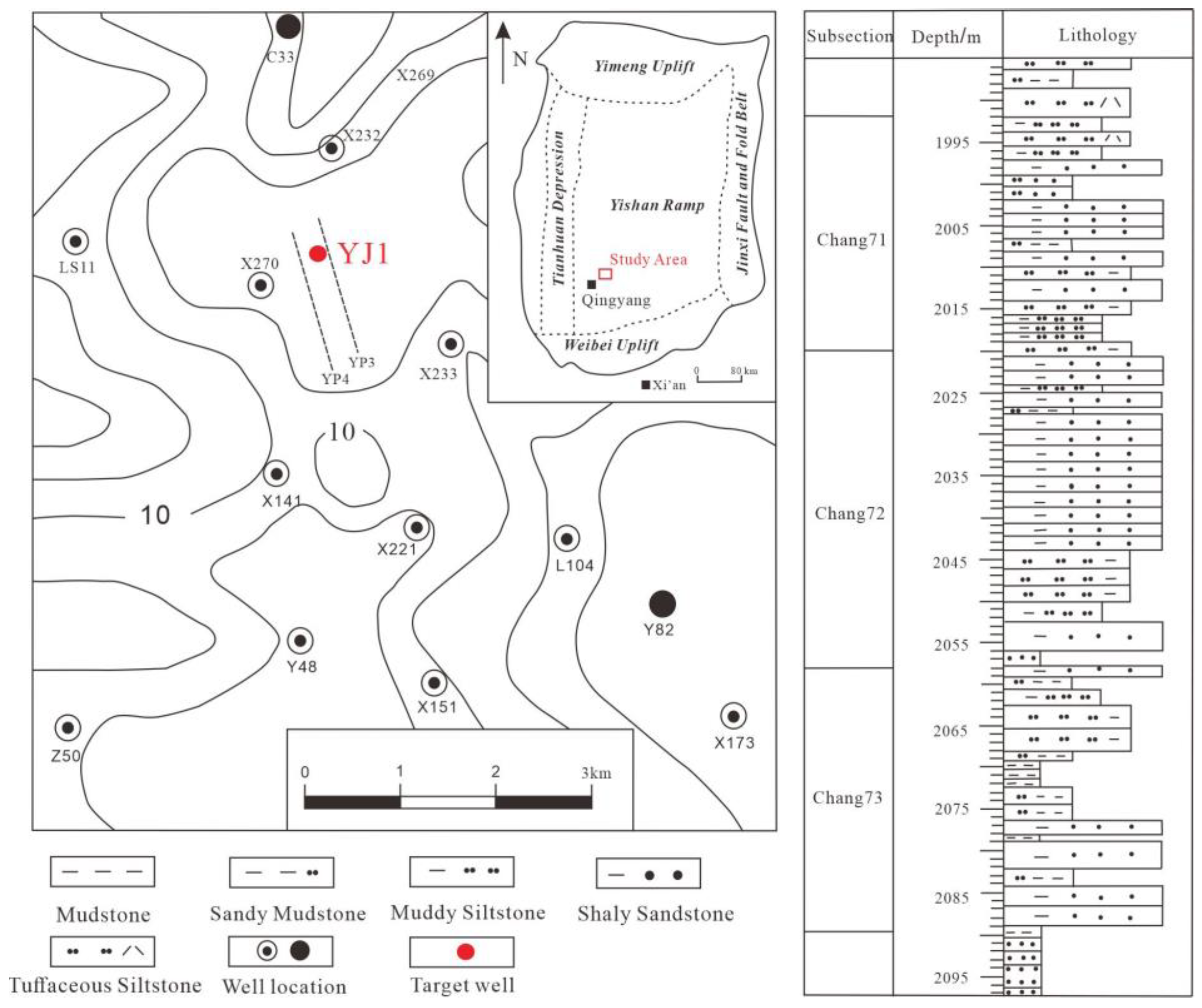


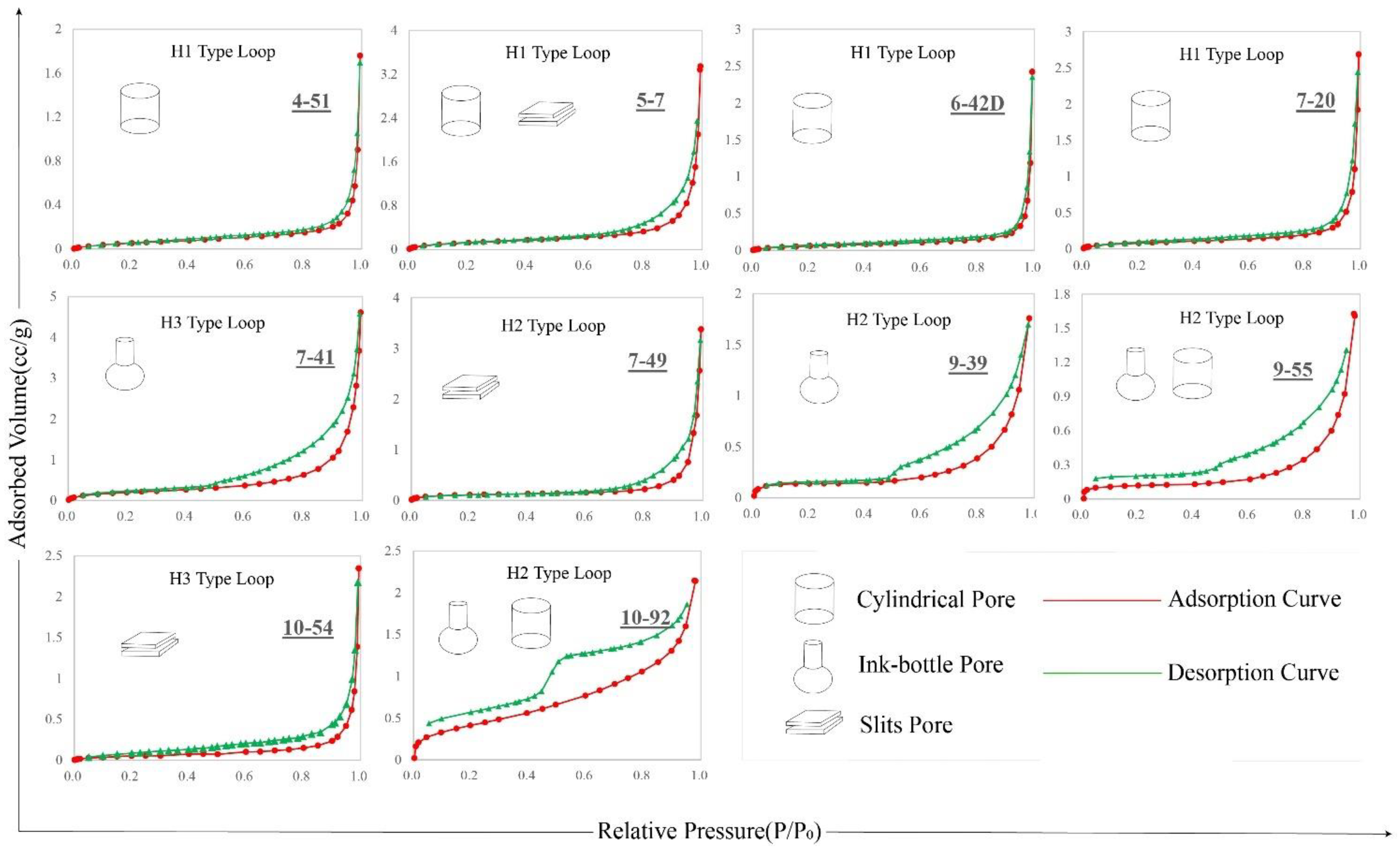

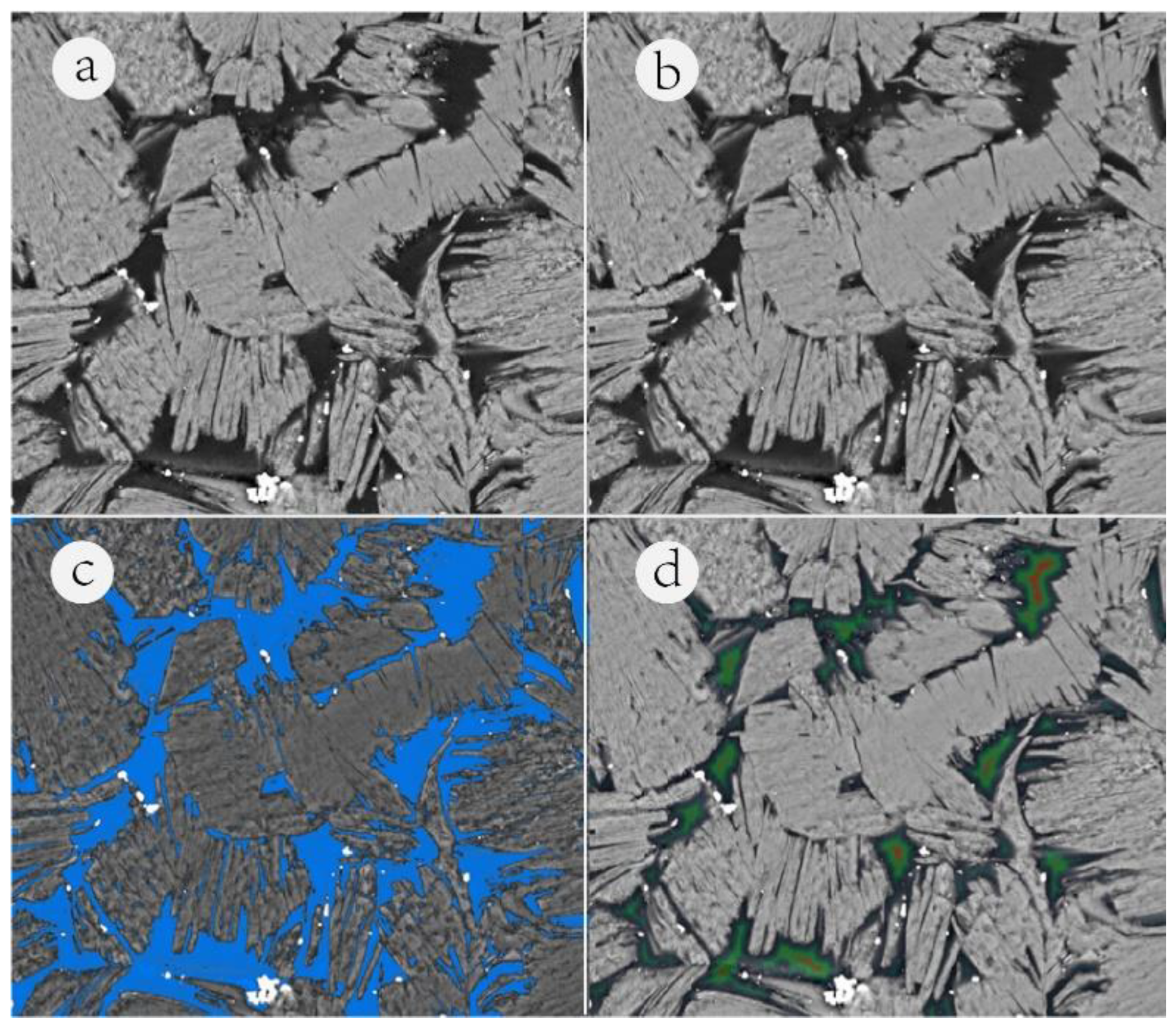

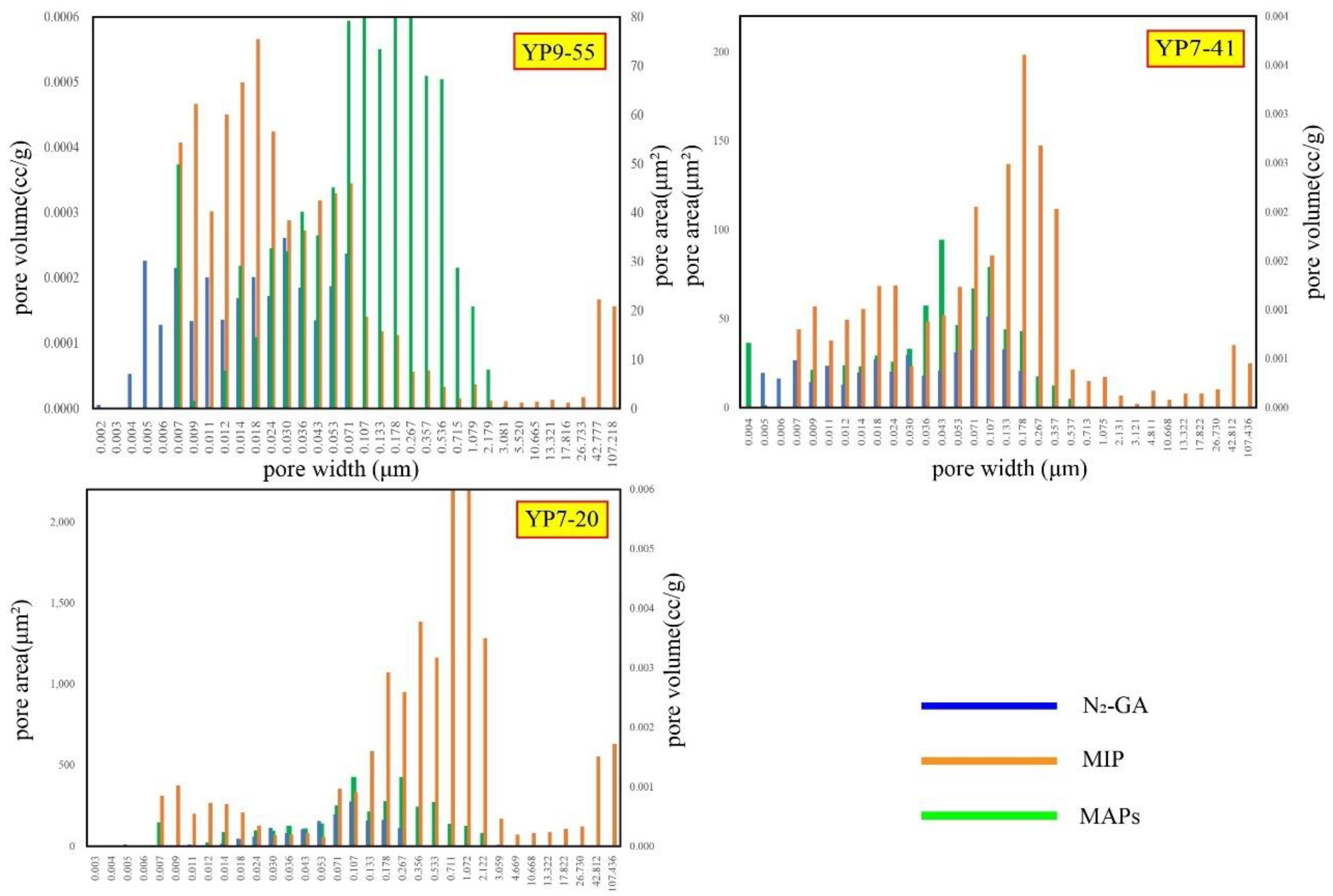

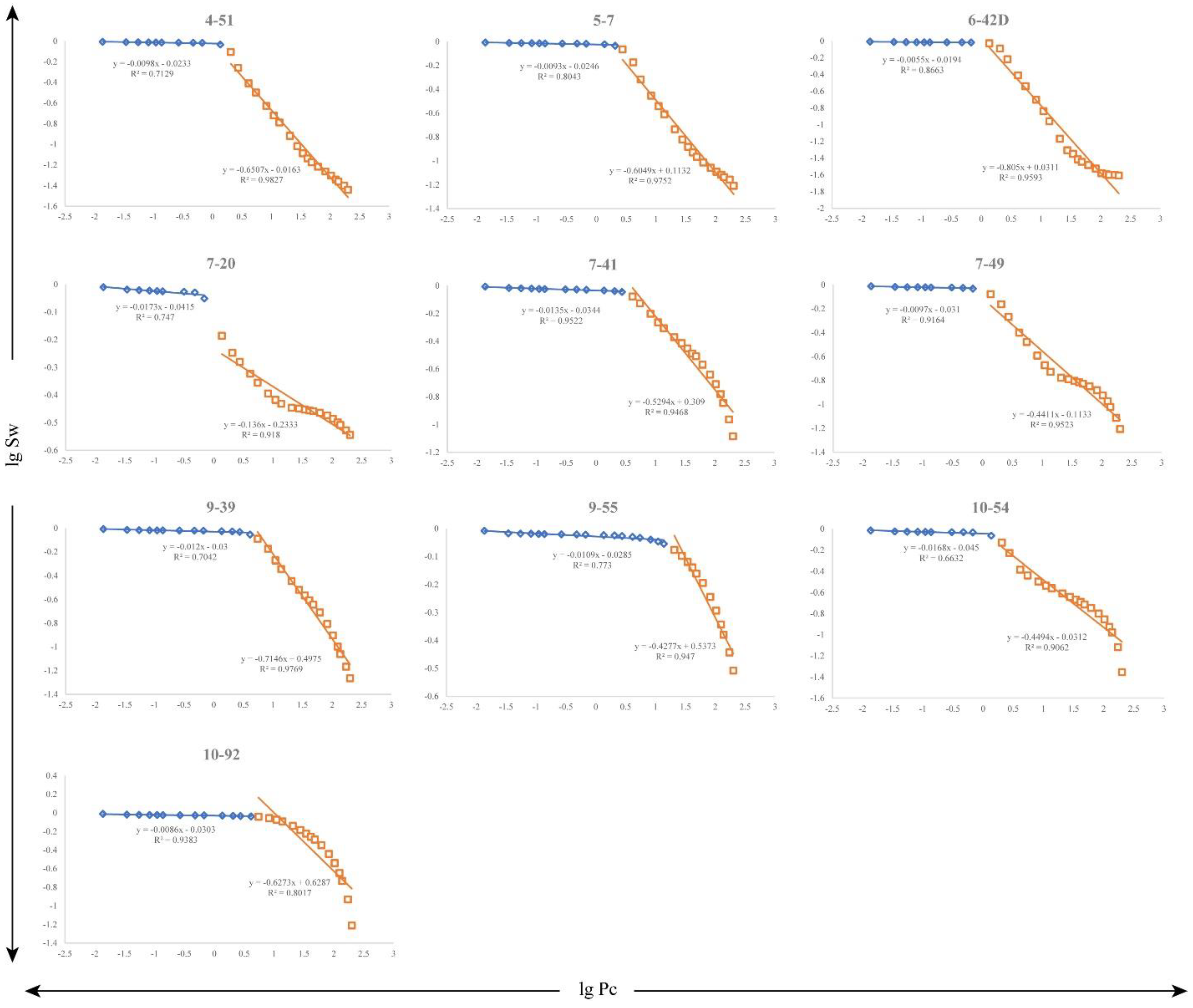
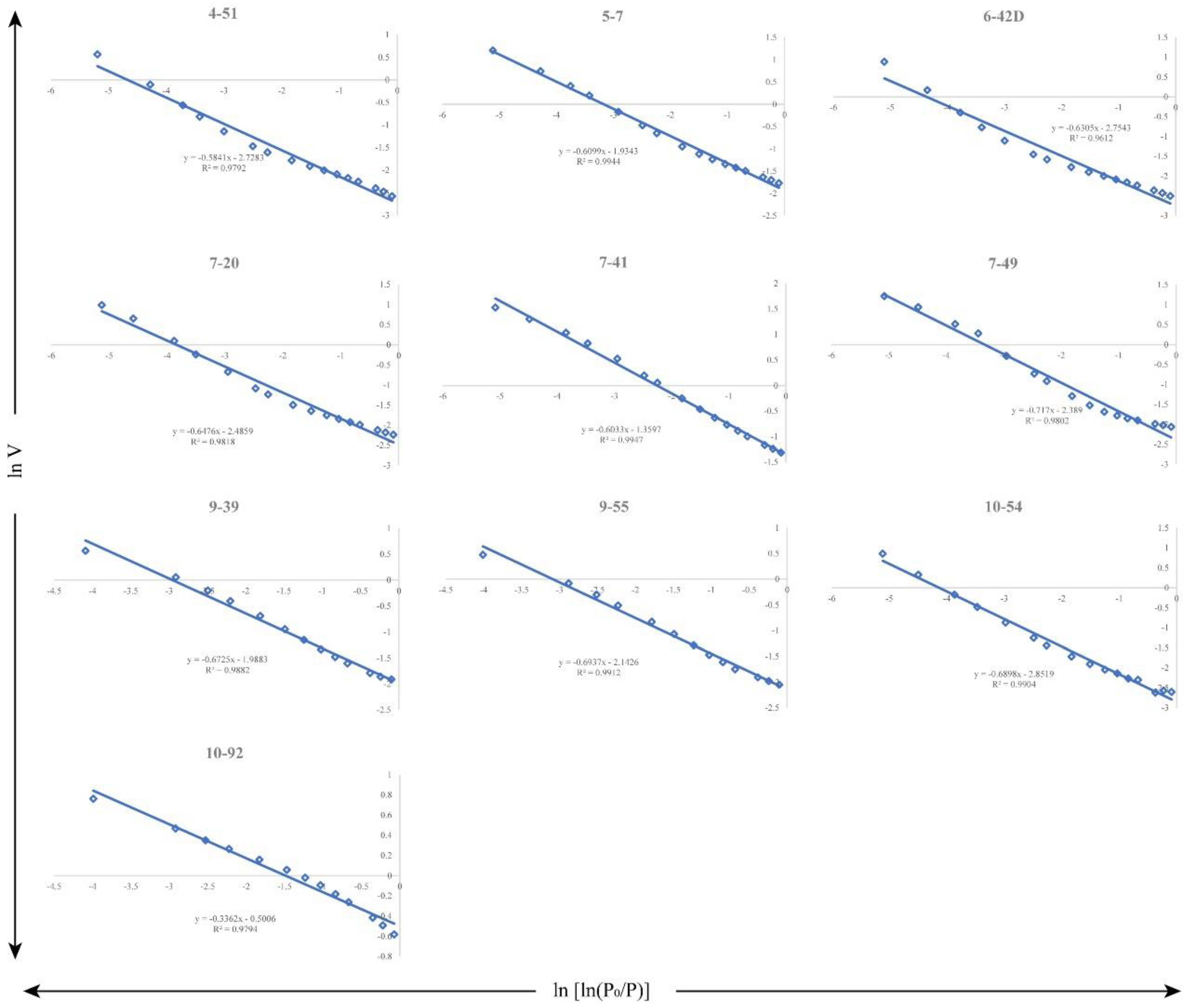
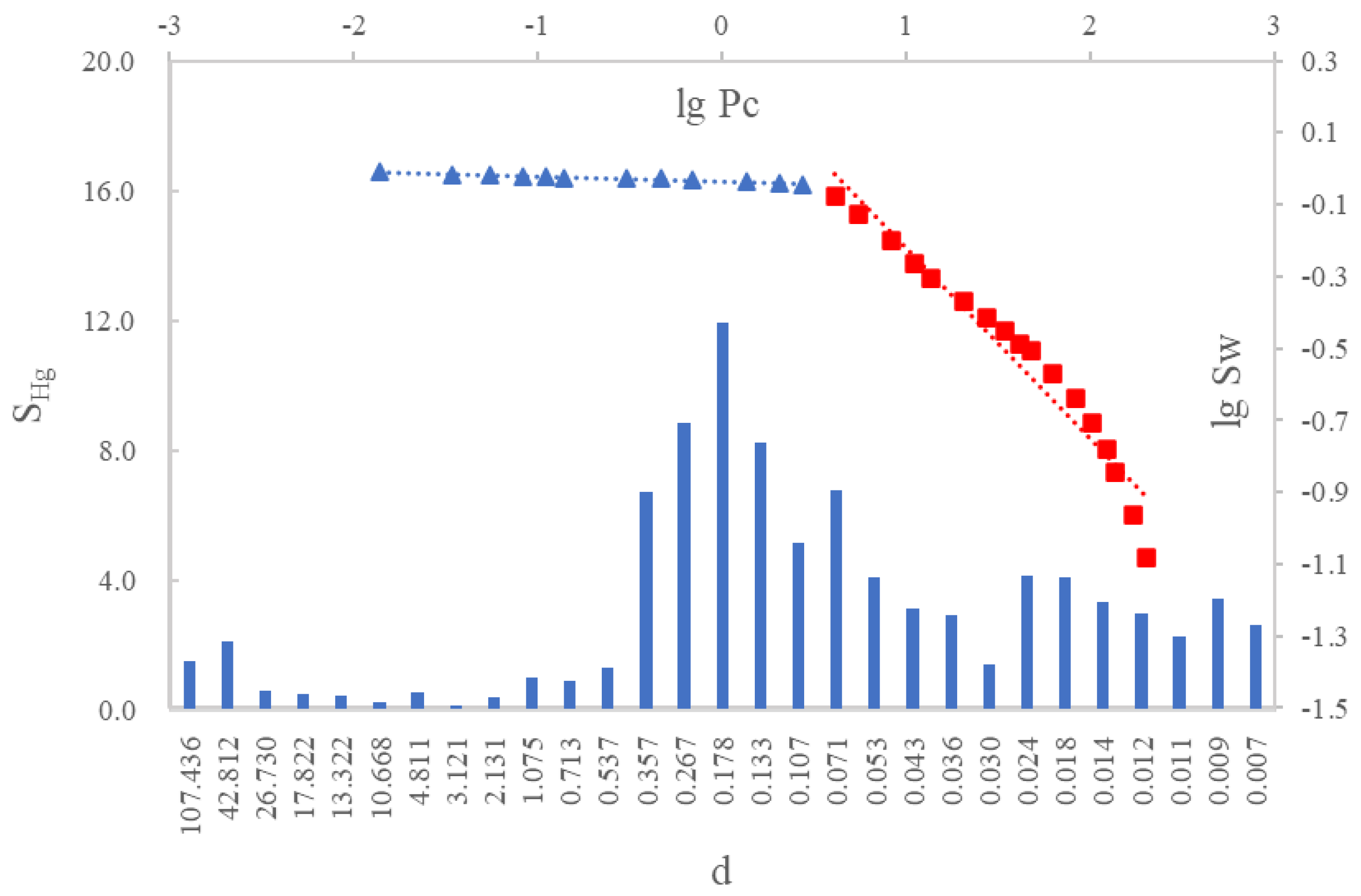
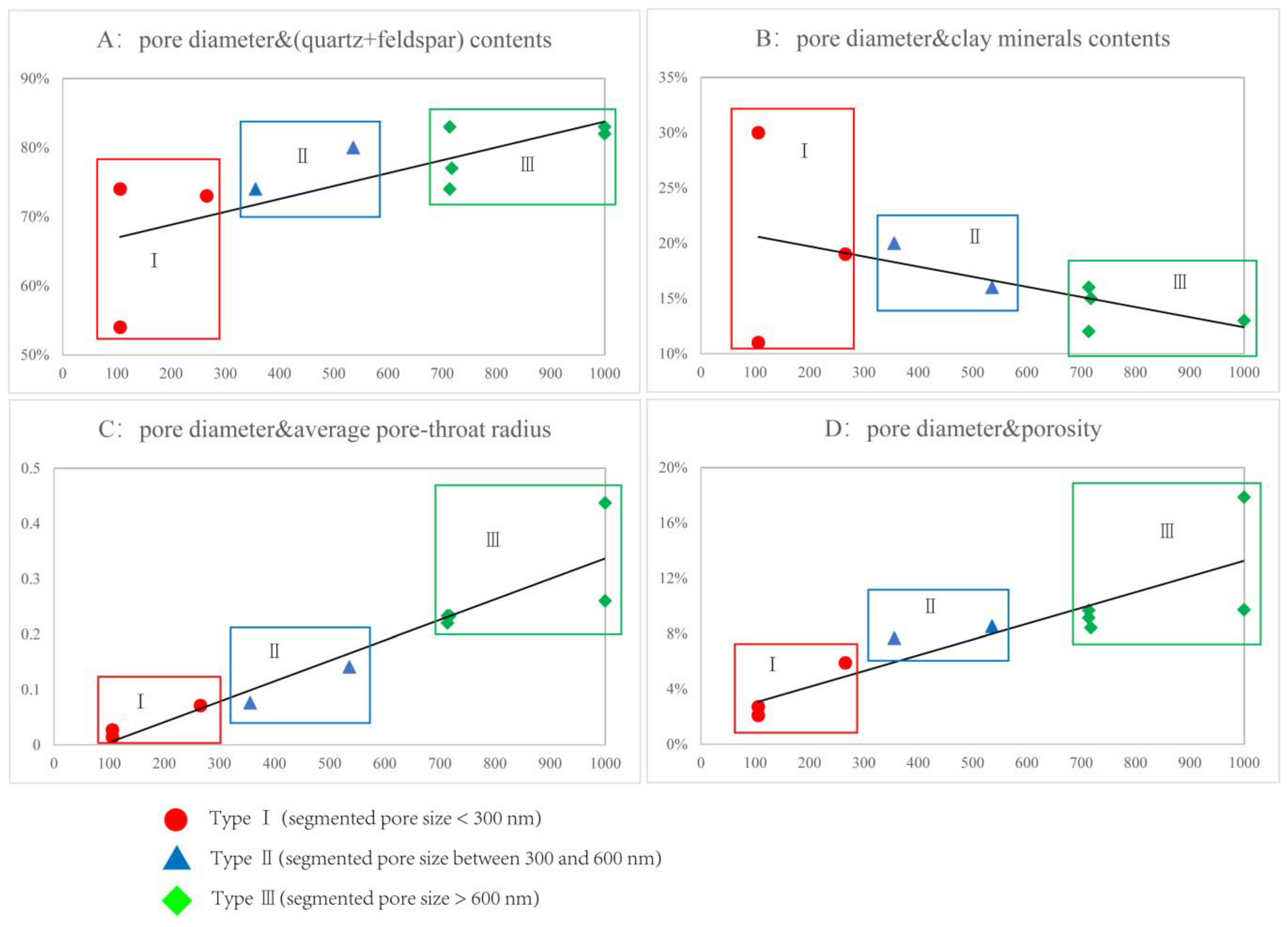
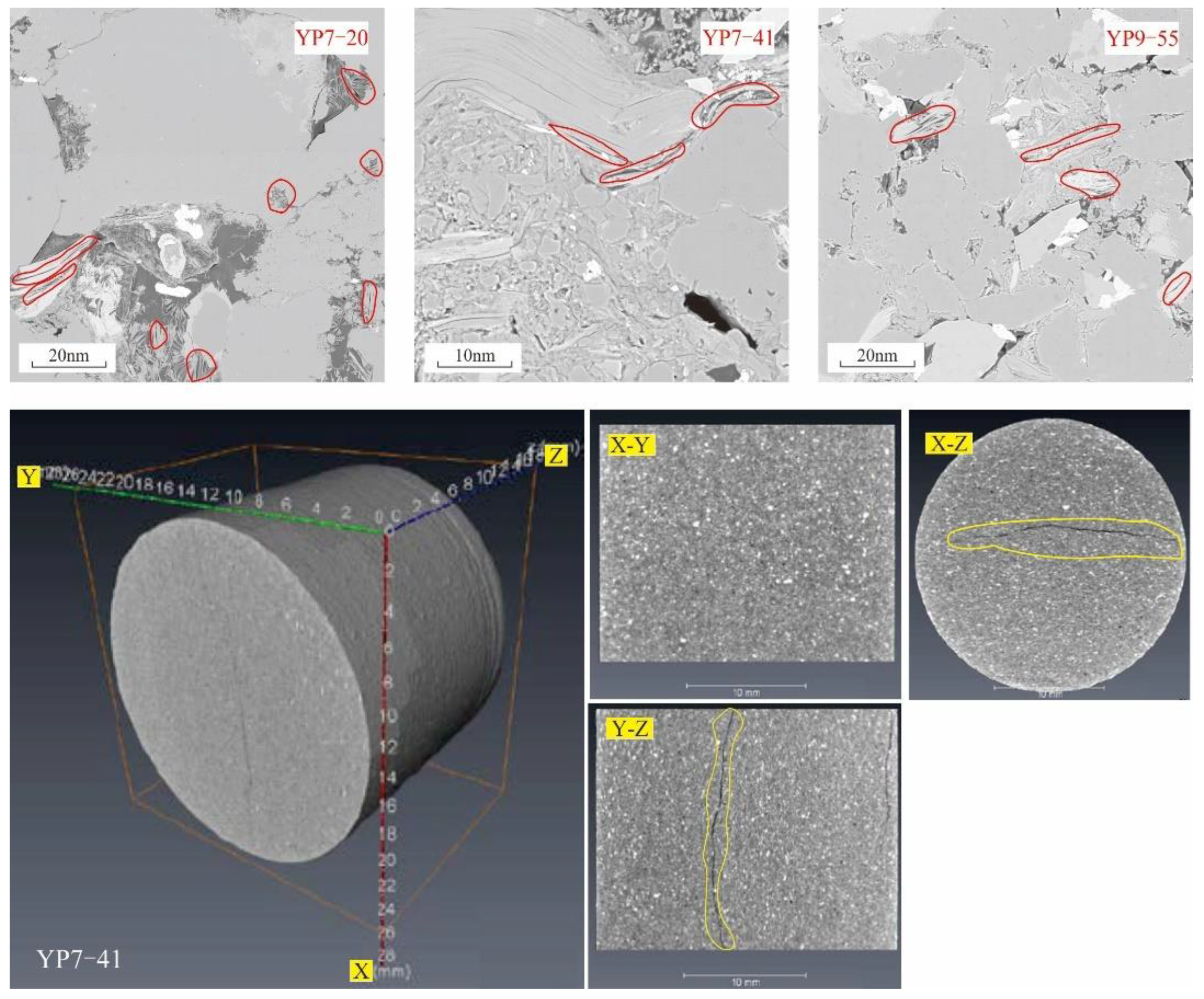
| Sample Number | Similarity ① | Similarity ② | Sample Number | Similarity ① | Similarity ② |
|---|---|---|---|---|---|
| 4-51 | 0.9546 | 0.6179 | 7-49 | 0.7745 | 0.3495 |
| 5-7 | 0.8802 | 0.2636 | 9-39 | 0.8534 | 0.5176 |
| 6-42D | 0.9243 | 0.4177 | 9-55 | 0.9392 | 0.3414 |
| 7-20 | 0.0004 | 0.5696 | 10-54 | 0.7354 | 0.6532 |
| 7-41 | 0.9347 | 0.4203 | 10-92 | 0.9400 | 0.6653 |
| Sample Number | MIP | Maps | ||||
|---|---|---|---|---|---|---|
| D1 | Segmented Fractal Pore Diameter (nm) | D2 | D1 | Segmented Fractal Pore Diameter (nm) | D2 | |
| 4-51 | 2.35 | 714 | 2.99 | — | — | — |
| 5-7 | 2.40 | 536 | 2.99 | — | — | — |
| 6-42D | 2.20 | 714 | 2.99 | — | — | — |
| 7-20 | 2.86 | 1000 | 2.98 | 1.17 | 356 | 1.92 |
| 7-41 | 2.47 | 356 | 2.99 | 1.20 | 356 | 1.96 |
| 7-49 | 2.56 | 1000 | 2.99 | — | — | — |
| 9-39 | 2.29 | 266 | 2.99 | — | — | — |
| 9-55 | 2.57 | 106 | 2.99 | 1.06 | 106 | 1.81 |
| 10-54 | 2.55 | 718 | 2.98 | — | — | — |
| 10-92 | 2.37 | 106 | 2.99 | — | — | — |
| Average | 2.46 | — | 2.99 | 1.14 | — | 1.90 |
Disclaimer/Publisher’s Note: The statements, opinions and data contained in all publications are solely those of the individual author(s) and contributor(s) and not of MDPI and/or the editor(s). MDPI and/or the editor(s) disclaim responsibility for any injury to people or property resulting from any ideas, methods, instructions or products referred to in the content. |
© 2023 by the authors. Licensee MDPI, Basel, Switzerland. This article is an open access article distributed under the terms and conditions of the Creative Commons Attribution (CC BY) license (https://creativecommons.org/licenses/by/4.0/).
Share and Cite
Zhang, C.; Guan, P.; Zhang, J.; Ding, X. Methodological Study on the Full-Range Pore Structure and Fractal Characteristics of the Tight Reservoirs. Minerals 2023, 13, 587. https://doi.org/10.3390/min13050587
Zhang C, Guan P, Zhang J, Ding X. Methodological Study on the Full-Range Pore Structure and Fractal Characteristics of the Tight Reservoirs. Minerals. 2023; 13(5):587. https://doi.org/10.3390/min13050587
Chicago/Turabian StyleZhang, Chi, Ping Guan, Jihua Zhang, and Xiaonan Ding. 2023. "Methodological Study on the Full-Range Pore Structure and Fractal Characteristics of the Tight Reservoirs" Minerals 13, no. 5: 587. https://doi.org/10.3390/min13050587






